Best electric vans with a 200-mile range or more
Are we entering the era of the 200-mile electric van? We look at the runners and riders in the market and coming to market soon.
Less than a decade ago, the idea of an electric van with a usable 200-mile range would have been a pipedream but the rapid growth of battery technology means it is now reality.
There’s now a glut of long-range electric vans to choose from and, with prices gradually dropping, electric vans will soon realise parity with petrol or diesel alternatives.
But let's dive a bit deeper and look at the options available in the market now and coming soon; we'll explore the 'official' WLTP figures issued by the manufacturer but also look at our own real world range figures.
So what are the advantages of going electric? Well, while electric vans are still more expensive to buy than a petrol or diesel model, they’re a lot cheaper to run. Charging your electric van at home will cost a fraction of the price of a tank full of diesel and electric vans are exempt from paying emissions-lowering schemes like the London Congestion Charge.
Electric vans are also cheaper to maintain. With fewer moving parts, there’s less to go wrong and motors don’t need the costly fluid changes of petrol and diesel engines.
Your decision to choose an electric van doesn’t need to be purely financial. You’ll find electric vans are very relaxing to drive because they have instant power, drive like an automatic and are very quiet and comfortable on the move.
Keep reading our guide to electric vans with a range of more than 200 miles to find out.
Renault Kangoo E-Tech – 186 miles WLTP | 135 miles real world range
The Renault Kangoo E-Tech is one of the best compact vans currently available because it’s easy to drive, has a decent range and has a spacious interior. You can choose from standard and Maxi models. Standard versions have a 3.3 cubic metre load bay and a 616kg payload, while Maxi models have a 4.2 cubic metre capacity and can haul loads weighing up to 800kg. All Kangoos are powered by a 90kW (121hp) electric motor that gives the van plenty of acceleration – 0-62mph takes 11.6 seconds – and the oomph needed for hauling heavy cargo. And the range? Well, the Kangoo will get up to 186 miles between charges according to WLTP figures, although lots of stop-start traffic and a light payload could increase that to more than 200 miles between charges. Charging the battery from 10-80% takes as little as 40 minutes using an 80kW rapid charger.
Our real world figure of what to expect is more like 135 miles.
Ford E-Transit – 196 miles WLTP | 150 miles real world range
The Ford E-Transit electric van has plenty going for it including surprising power, a well-equipped interior and a wide range of configurations that make it suitable for almost any job. The Ford E-transit’s 68kWh battery gives it a 196-mile range in mixed driving but stay in the city – where the van’s regenerative brakes can recharge its battery more effectively – and a range of more than 200 miles could be possible.
Meanwhile, Ford has stated a figure of more than 100 miles if the E-Transit is fully laden and all seats occupied.
Our estimation is that over a period of time and under various driving conditions we expect the E-Transit to cover around 150 miles on a full charge.
Charging the battery from 15-80% takes as little as 45 minutes from a public fast charger. With a 195kW (261hp) motor, the E-Transit has more performance than you could dream of and its sophisticated multi-link rear suspension means it’s more comfortable than a van has any right to be. Having said that, the E-Transit hasn’t forgotten its reason for being – it can still haul a payload of up to 1758kg and offers a load capacity of up to 15.1 cubic metres.
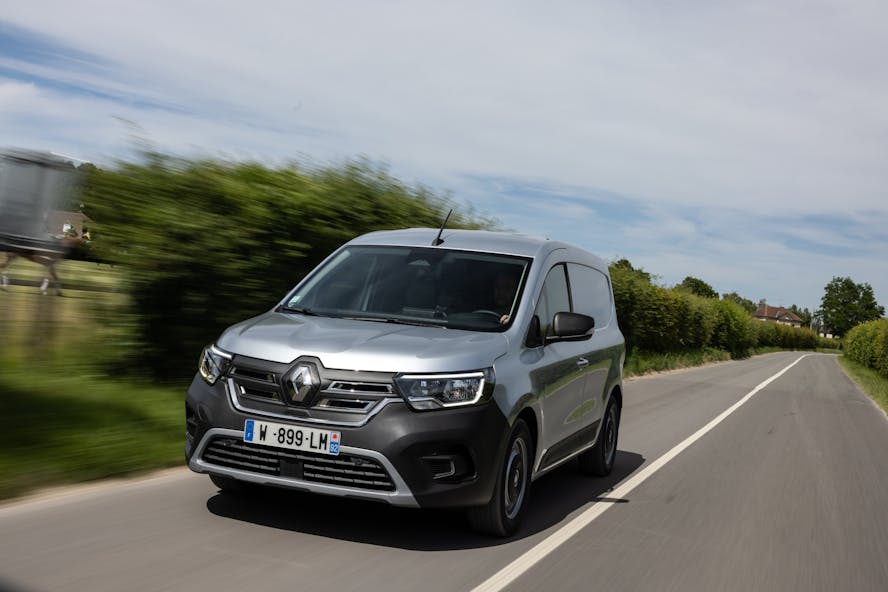
Renault Kangoo E-Tech
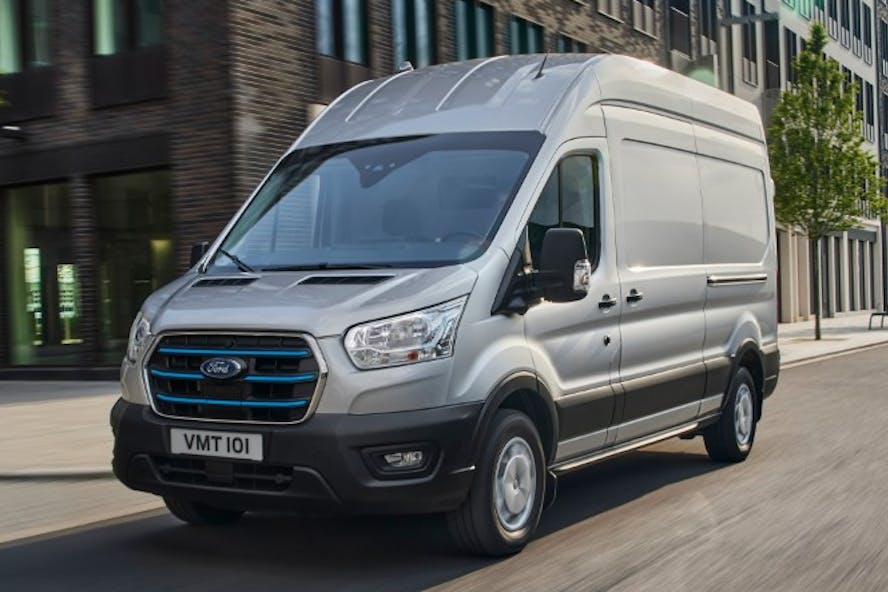
Ford E-Transit
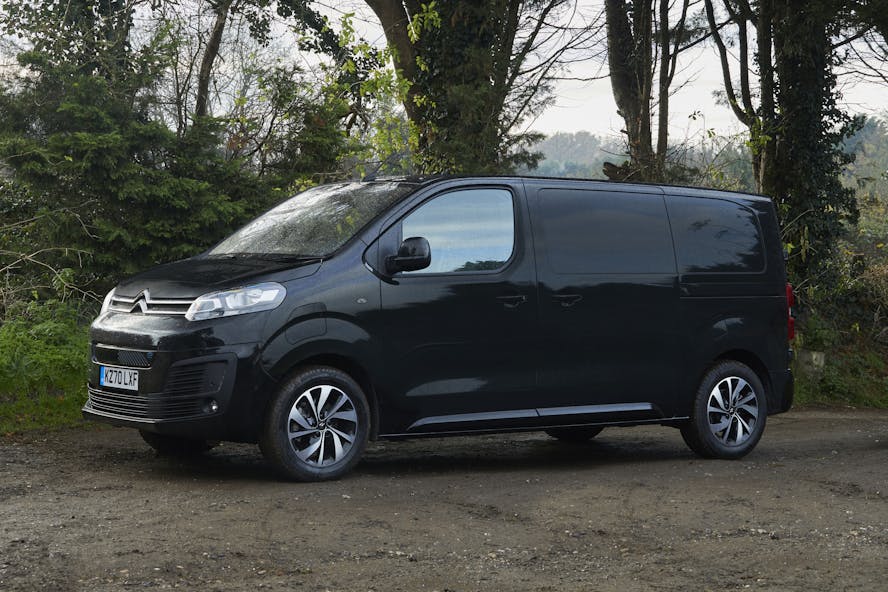
Citroen e-Dispatch
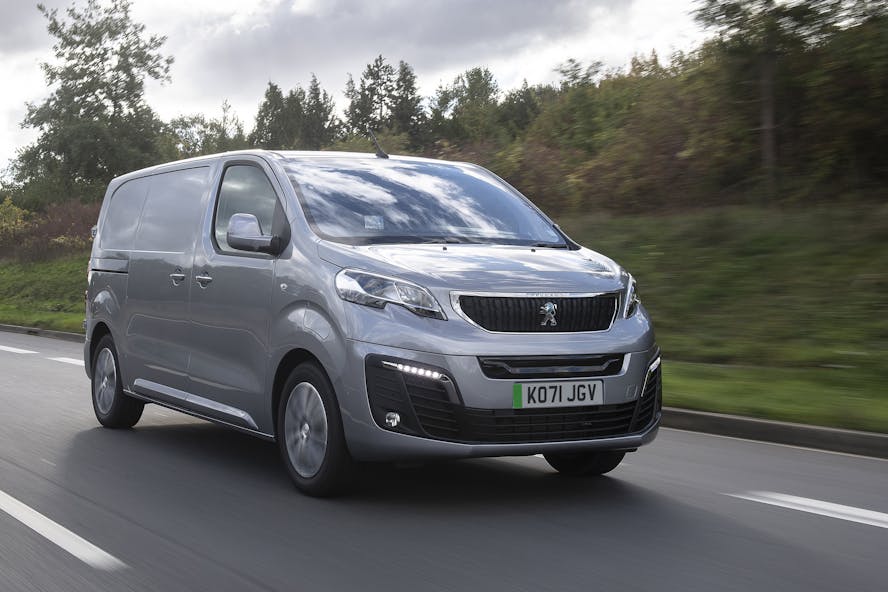
Peugeot e-Expert
Citroen e-Dispatch – 205 miles WLTP | 155 miles real world range
The Citroen e-Dispatch is the first van on this list to boast a range of more than 200 miles over a mixture of driving, according to WLTP figures. Fitted with the company’s 75kWh battery, it can travel up to 205 miles between charges and filling the battery from 0-80% takes 45 minutes using a 100kWh public charger.
However, under real world conditions we expect the 75kWh e-Dispatch to cover around 155 miles on a charge. More than enough for lots of uses but falls short of the 200 mile figure.
With 100kW (or 136hp) to call on from its front electric motor, the e-Dispatch doesn’t have the startling performance of the Ford transit but it still has the power needed to shift a payload of more than 1000kg with a load volume of up to 6.6 cubic metres. You get three sizes of e-Dispatch to choose between – XS, M and XL – and all come with sliding doors on either side for maximum accessibility. All versions can also tow up to 1000kg. The e-Dispatch comes well equipped, even basic examples have air-conditioning, while mid-range models get rear parking sensors and top-of-the-range models have sat-nav and a head-up display.
Peugeot e-Expert – 205 miles WLTP | 155 real world range
The Peugeot e-Expert shares its underpinnings with the Citroen e-Dispatch and like it, you can choose from 50 or 75kWh batteries – it’s the latter that gives you a WLTP range of 205 miles. And just like the Citroen e-Dispatch we expect the more realistic range of the electric van to be around 155 miles on a fully charge.
Like the Citroen, the Peugeot’s interior can feel tight if you and your passengers are tall but on the flip side, the driving experience is very relaxing thanks to the instant power and silent running of the Peugeot’s 100kW (136hp) electric motor that spins the front wheels. Performance is adequate rather than brisk but with instant power and a single-speed gearbox, the e-Expert is very easy to drive in stop-start traffic. And charging? Well, the Peugeot can charge at speeds of up to 100kW meaning you can fill the battery from 0-80% in 45 minutes using a publicly available fast charger. You can choose from Compact, Standard and Long versions that range from 4950mm to 5300mm in length with a load volume of up to 6.6 cubic metres. All models can tow up to 1000kg and come with sliding doors on both sides.
Toyota Proace Electric – 205 miles WLTP | 155 miles real world range
The Toyota Proace Electric shares its underpinnings with the Peugeot e-Expert and Citroen e-Dispatch but it has a USP to help it stand out – a five-year/100,000-mile warranty that is two years longer than average. Naturally, you can also rely on Toyota’s excellent reputation for reliability. The Proace is more conventional elsewhere. It has the same 75kWh battery and 100kW (136hp) electric motor that’s fitted to the Citroen and Peugeot, which gives it reasonable performance and makes it relaxing to drive. Charging the battery from 0-80% takes as little as 45 minutes using a publicly available fast charger. The Proace Electric only comes in one size with a 5.3 cubic metre load bay and a 1000kg payload. You also get sliding doors on either side that make it easy to make the most of all that space.
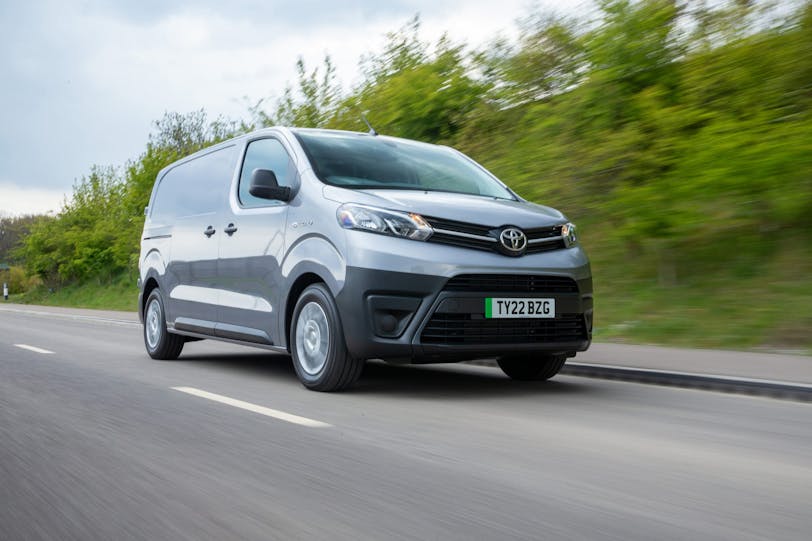
Vauxhall Vivaro-e – 205 miles WLTP | 155 miles real world range
The Vauxhall Vivaro-e is a relatively affordable way of getting behind the wheel of an electric van with a decent range, and it shares its underpinnings with the Citroen e-Dispatch, Peugeot e-Expert, Toyota Proace Electric and Fiat eScudo. As a result, it uses the same combination of a 75kWh battery and a 100kW (136hp) electric motor to give you decent performance and a range of 205 miles in a mixture of driving under the WLTP test cycle. It also charges at the same speed with a 0-80% charge taking 45 minutes using a public fast charger. Inside, the Vivaro offers a load volume of up to 6.6 cubic metres, a maximum payload of 1000kg and a 1000kg towing capacity. But why would choose the Vauxhall over any of the other vans it is based upon? Residuals. The Vauxhall badge’s popularity in the UK means the Vivaro-e should hold its value better than most alternatives.
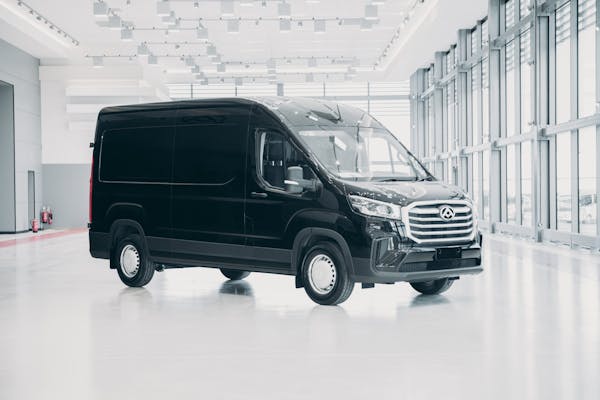
Maxus eDeliver9 – 219 miles WLTP | 165 miles real world range
The Maxus eDelivery 9 was one of the first electric vans to claim a range of more than 200 miles – fitted with an 89kWh battery, the largest option, it’ll do up to 219 miles of city driving between charges according to WLTP figures.
As with all electric vehicles, there's a difference between WLTP figures and those experienced under real world conditions, therefore at DriveElectric we expect the 89kWh van to travel around 165 miles on a full charge.
DC fast charging means you can top the battery up from 10-80% in as little as 45 minutes. You get plenty of power thanks to a 150kW (201hp) electric motor and having the heavy batteries hidden deep in the floor means the Maxus handles predictably, even if eDelivery isn’t as quiet and comfortable as some alternatives. To get the big battery, you’ll need to go for the 5940mm long-wheelbase model that has a maximum payload of 860kg. Its load area has a height of 1792mm and a volume of 11 cubic metres, plus you get a sliding side door, bright LED lighting, eight tie-down hooks and a non-slip coating on the floor.
Arrival Van – 233 miles ESTIMATED
The Arrival Van comes from a British startup that hopes to deliver its first vans by the end of the year. Worth holding on for? Yes.
Arrival looks set to turn the electric van market on its head by offering a van made from lightweight aluminium and composites, to save weight. Power comes from a 150kW electric motor which produces the equivalent of 201hp and is mated to a two-speed automatic gearbox with a cruising gear that’ll help save power at motorway speeds. The result? A 233 miles range when fitted with Arrival’s colossal 133kWh battery.
The large battery pack and innovative design should mean that the Arrival van, when it arrives, could be one of the very first electric commercial vehicles to achieve the 200 mile range under real world conditions.
The Arrival van should blow your expectations in terms of practicality, too. It boasts a load volume of up to 14.6 cubic metres and can carry a payload of up to 1975kg. Meanwhile, the Arrival’s composite panels mean you don’t need to worry about rust and bodywork repairs should be cheap.
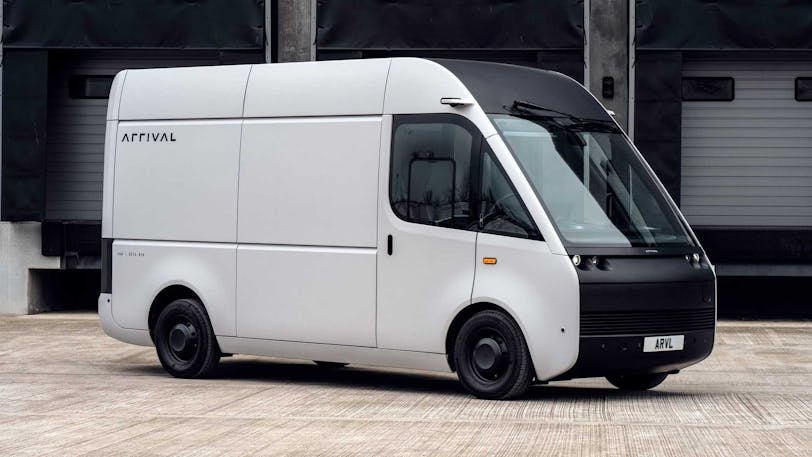
Renault Zoe Van – 245 miles WLTP | 200 miles real world range
The Renault Zoe Van is based on a car so it can’t offer the practicality of the panel van alternatives found here. But, what it lacks in capacity the Zoe more than makes up for in range and manoeuvrability. It’s powered by a 50kW battery that in a van the size of the Zoe, is enough for a range of up to 245 miles under the WLTP test cycle, with fast charging that means you can add 90 miles of range in 30 minutes. The Zoe’s 80kW electric motor produces 107bhp giving it zippy performance and the Renault’s small size makes it ideal for slicing through bustling city streets. Downsides?
Well, the Renault is a lot less practical than the rest of the vans on this list, with a load volume of just 0.51 cubic metres and a payload of 387kg.
So we'll leave it with you if you consider the Zoe van to be a true commercial vehicle...
VW ID. Buzz Cargo – 256 miles WLTP | 205 real world range
The Volkswagen ID. Buzz Cargo offers something no other van on this list does – desirability, thanks to a heritage that can be traced way back to the hippy youth culture of the 1960s. Despite its trendy image, the ID.Buzz Cargo is a working van with a 3.9 cubic metre load volume and 752kg payload, although both fall short of what other vans offer here. Power comes from a 77kWh battery that gives the Cargo an impressive range of up to 258 miles, while a 170kWh charging speed means you can get the battery from 5-80% full in just 30 minutes.
Power comes from a 150kW (201bhp) electric motor that accelerates the VW from 0-62mph in around 10 seconds giving you plenty of performance and the van’s tight 11.1m turning circle makes it highly manoeuvrable.
At DriveElectric, we believe that the Volkswagen ID. Buzz Cargo is the first versatile pure electric light commercial vehicle which can realistically achieve and breakthrough the 200 mile real world range barrier.
Downsides? Well, the ID. Buzz Cargo’s cool image and fancy two-tone paint jobs mean it costs significantly more than its rivals.
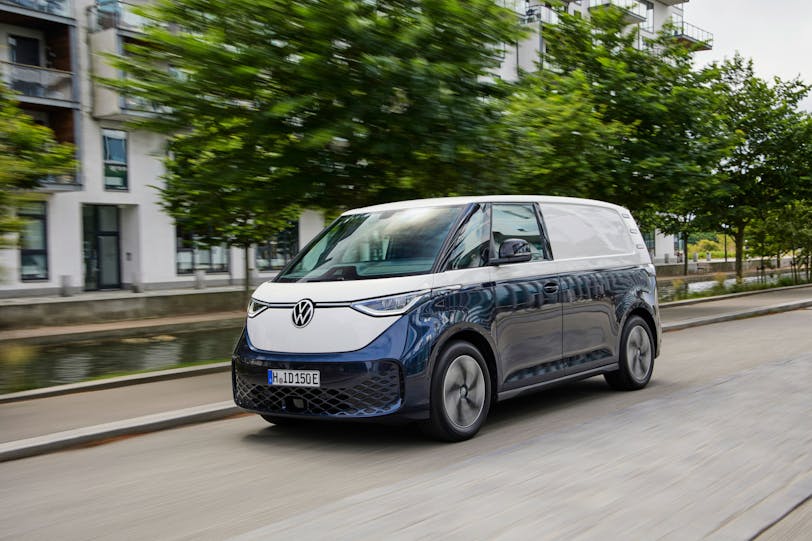
How long does it take to charge an electric van with a 200-mile range?
Charging times are one of the biggest stumbling blocks to buying an electric van because while filling a diesel’s fuel tank takes a matter of seconds, recharging the battery of an electric van with a 200-mile range takes several hours – 11 hours 20 minutes to be exact, using the Citroen e-Dispatch as an example – using a wall mounted 7kW charger at home.
Using a standard 3-pin plug and charging a van with a range of more than 200 miles will likely take more than 40 hours. Something we do recommend.
However, when using a combination of location, destination and workplace charging allows for the electric van to be topped up when not in use; i.e. charging overnight in the work's compound or making use of a home charger.
All is not lost though because, as well as being capable of travelling around 200 miles on a single charge, all the vans on this list offer a fast-charging capability that means their batteries can be charged from 0-80% in a matter of minutes – not hours – using a powerful rapid or ultra-rapid public charger. Essentially, you can get an 80% charge on your lunch break.
How much does it cost to charge an electric van?
How much it costs to charge your van will depend on where you’ll charge it.
The most expensive option is a public rapid charger and worst case scenario. The spiralling wholesale cost of electricity means that you’ll pay on average 63.29p per kWh of electricity at a fast charger, meaning a long-range electric van like the Citroen e-Dispatch with a 75kWh battery and a 205-mile range, will cost about £50 to give a full charge.
Charging your van at home – either using a specific wall-mounted charger or a standard three-prong plug – will be much cheaper.
Data released by the RAC found that owners pay on average 9p per mile of electricity. Charging at home means you also benefit from electric-vehicle-specific electricity tariffs, and you’re exempt from the 20% VAT charge you’ll pay when you use a public charger.
An increasing number of businesses are installing workplace charging which allows electric vans to be recharged overnight, when electricity rates are typically lower and electricity generation has a lower carbon footprint.
Are WLTP figures accurate?
WLTP (Worldwide Harmonised Light Vehicles Test Procedure) real-world testing standards are designed to be more accurate than the NEDC (New European Driving Cycle) lab tests that they replace.
That being said, the official WLTP range quoted for your electric van won’t always tally up with the range you get in the real world.
Several variables could affect your electric van’s range – factors such as ambient temperature, payload, style of driving, and use of equipment like the van’s heater and air-conditioning, can all affect an electric van’s range.
Another big factor is where you’ll intend to drive. While a diesel van will be more efficient on the motorway, an electric model will be better in town, where its regenerative brakes get plenty of opportunity to help top up the battery and increase range.
As a result, WLTP figures are best treated as a comparative tool or as a best-case-scenario range. Many manufacturers have an online calculator that can give you a more accurate idea of the range you can expect based on the kind of driving you’ll do in your electric van. And here at DriveElectric we like to include more realistic real world range figures - including separate figures for summer and winter driving.
More EV guides
Understanding Vehicle Excise Duty (VED) or "Road Tax" for EVs
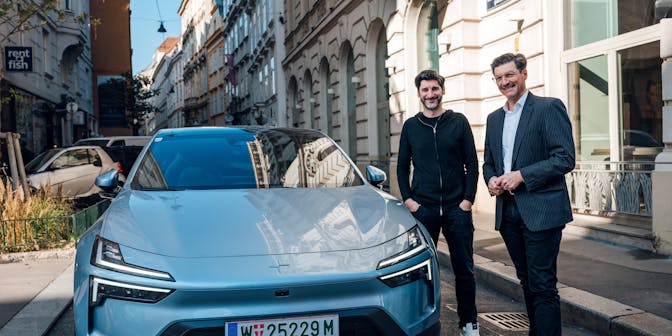
How to save money on a new car with Salary Sacrifice
How is salary sacrifice calculated?
